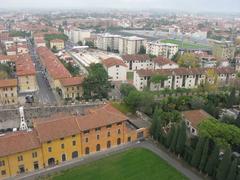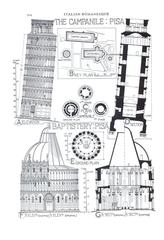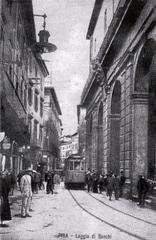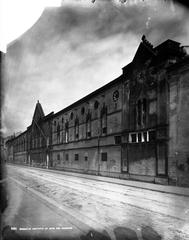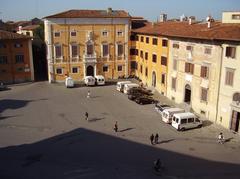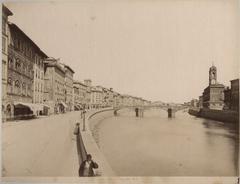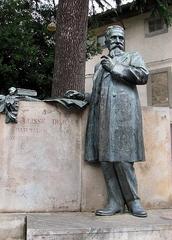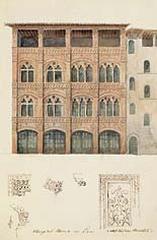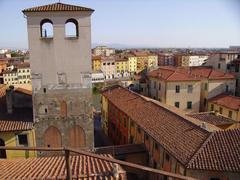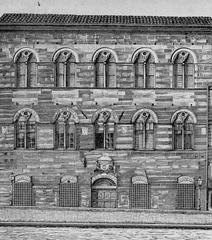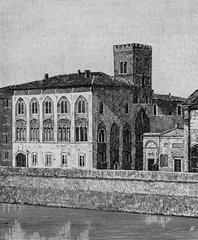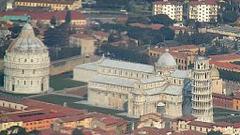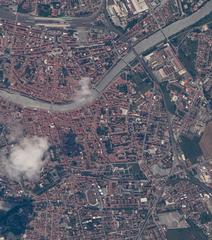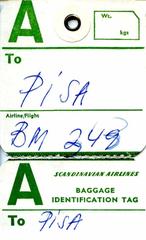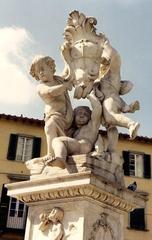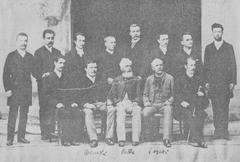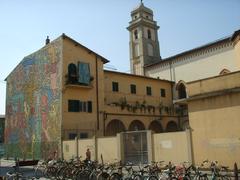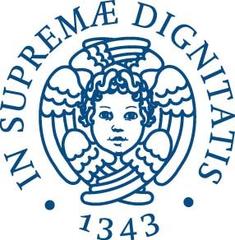Palazzo Gambacorta Visiting Hours, Tickets, and Pisa Historical Sites Guide
Date: 14/06/2025
Introduction to Palazzo Gambacorta
Centrally positioned along the scenic Lungarno Gambacorti on the northern bank of the Arno River, Palazzo Gambacorta stands as a cornerstone of Pisa’s architectural and civic history. This palazzo seamlessly blends Gothic fortifications with Renaissance elegance, bearing witness to Pisa’s political, cultural, and artistic evolution. Originally constructed in the early 14th century by the influential Gambacorta family—one of Pisa’s foremost aristocratic dynasties—the palace was both a sumptuous residence and a dynamic political center (Pisa Tour, Forza Pisa).
Today, Palazzo Gambacorta is the seat of Pisa’s city council and continues to host civic ceremonies and cultural events, reinforcing its enduring significance in the city’s urban fabric (Italia Mia, Visittuscany.com). Visitors are welcomed into its frescoed halls and tranquil courtyard, where centuries of history and artistry are on vivid display. Its central location makes it an excellent complement to visits to nearby highlights like the Piazza dei Miracoli and Palazzo Blu.
Whether you’re an architecture enthusiast, history lover, or cultural traveler, this guide provides all the information you need—visiting hours, ticketing details, accessibility tips, and travel advice—ensuring a rewarding experience at one of Pisa’s most treasured landmarks (Pisa Tour, The Tuscan Mom).
Table of Contents
- Introduction
- Historical Overview
- Visitor Information
- Frequently Asked Questions (FAQ)
- Conclusion
- References
Historical Overview
Origins and Construction
Palazzo Gambacorta was commissioned in the early 14th century by the Gambacorta family, whose prominence in Pisa’s commerce and governance shaped the city’s fortunes. The palace’s original design, combining fortified elements with early Renaissance flourishes, reflects both the family’s aspirations and the turbulent political context of medieval Pisa (Pisa Tour).
Architectural Evolution and Features
The palazzo’s architecture mirrors Pisa’s transition from medieval to Renaissance sensibilities. The Gothic facade—characterized by crenellations, pointed arches, and robust stonework—is complemented by later Renaissance additions such as frescoed halls, stucco decorations, and ornate wooden ceilings (Visittuscany.com). The grand portal, embellished with the Gambacorta family crest, and the arcaded internal courtyard are highlights of its evolving design.
The Gambacorta Family and Political Significance
The Gambacorta family’s influence peaked under Pietro Gambacorta (1370–1392), when the palace functioned as a hub for strategic decision-making and alliances aimed at securing Pisa’s independence in rivalry with neighboring city-states (Pisa Tour). The assassination of Pietro Gambacorta in 1392 marked a significant turning point in Pisan history.
Transition to Civic Use
Following the family’s decline and Pisa’s conquest by Florence in 1405 (Oxford Bibliographies), the palazzo was converted to serve as the city’s municipal headquarters—a role it continues to fulfill as the Palazzo Comunale. This shift from aristocratic residence to civic landmark reflects broader transformations in Pisa’s governance.
Restoration and Preservation
Extensive restoration in the 19th and 20th centuries preserved the palazzo’s structure and decorative elements, balancing historical authenticity with modern civic needs (Pisa Tour). Conservation work continues to ensure the building remains accessible to the public while retaining its artistic and architectural integrity.
Role in Modern Pisa
Today, Palazzo Gambacorta is the heart of Pisa’s civic life, hosting official meetings, public ceremonies, and cultural events. Its proximity to the city’s main attractions makes it a focal point for both locals and tourists (Italia Mia).
Notable Events & Artistic Legacy
The palazzo has witnessed pivotal moments, from the assassination of Pietro Gambacorta to contemporary celebrations such as the Luminara di San Ranieri. Its halls are adorned with frescoes depicting Pisa’s maritime triumphs and civic pride, underscoring its role as a living testament to the city’s artistic and political heritage (Pisa Tour).
Visitor Information
Visiting Hours
- General Opening Hours: Tuesday to Sunday, 10:00 AM–6:00 PM (closed on Mondays and public holidays).
- Special Events: Opening hours may vary; always check the official website or local tourist information for updates.
Tickets and Admission
- Admission: Free for Pisa residents and children under 18; other visitors typically pay an entry fee (around €5–€10 depending on event or tour).
- Guided Tours: Available for an additional fee; recommended for deeper insight into the palazzo’s history and art.
- Booking: Purchase tickets online through official platforms or at the entrance. Advance booking is recommended, especially during peak seasons.
Accessibility
- Wheelchair Access: Ramps and elevators are installed in key areas; some historic sections may remain inaccessible due to preservation requirements.
- Assistance: Visitors with special needs should contact the palazzo in advance to arrange accommodations.
Guided Tours and Events
- Guided Tours: Offered in several languages and led by knowledgeable guides, these tours cover the main halls, council chambers, and select rooms.
- Special Events: The palazzo regularly hosts civic ceremonies, exhibitions, and cultural happenings. Check the official calendar for upcoming events.
How to Get There
- On Foot: A 15–25 minute walk from Pisa Centrale train station through the city center.
- By Car: Public parking lots and attended garages are available nearby; do not leave valuables in vehicles (The Tuscan Mom).
- By Bus: Several local bus routes stop close to Lungarno Gambacorti.
Nearby Attractions
- Piazza dei Miracoli: Iconic home to the Leaning Tower and Pisa Cathedral.
- Palazzo Blu: Renowned art museum along the Arno.
- Church of Santa Maria della Spina: Celebrated Gothic church by the river.
- Historic Bridges and Markets: Including Ponte di Mezzo and Logge di Banchi.
Practical Tips
- Best Time to Visit: Early morning or late afternoon for a quieter experience and better lighting for photography.
- Photography: Exterior photography is welcome; interior photography may be restricted—please check with staff.
- Combine Visits: Take advantage of the palazzo’s central location to explore multiple Pisa historical sites in one day.
Frequently Asked Questions (FAQ)
Q: What are the visiting hours of Palazzo Gambacorta?
A: Tuesday to Sunday, 10:00 AM–6:00 PM; closed on Mondays and major holidays. Hours may change for special events.
Q: Are tickets required for entry?
A: Admission is free for Pisa residents and children under 18; other visitors pay a modest fee. Guided tours and events may have separate ticketing.
Q: Is the palazzo wheelchair accessible?
A: Yes, most key areas are accessible, but some historic sections may have limitations.
Q: How do I book a guided tour?
A: Book online via official platforms or at local tourist offices. Advance booking is advised.
Q: Can I take photos inside Palazzo Gambacorta?
A: Exterior photography is allowed. Interior photography may be restricted; confirm with staff on arrival.
Conclusion
Palazzo Gambacorta is not just a historic building but an enduring symbol of Pisa’s political, artistic, and civic legacy. Its blend of Gothic and Renaissance architecture, evocative frescoes, and strategic location make it a must-see for any visitor. With accessible visiting hours, affordable tickets, and insightful guided tours, Palazzo Gambacorta offers a profound connection to the city’s past and present. Plan your visit today to discover the living heart of Pisa’s heritage.
For personalized guides and the latest updates on Pisa’s historical sites, download the Audiala app and follow our social media channels.
